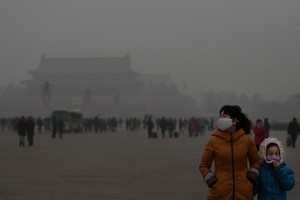
BEIJING, CHINA – Tiananmen Square, January 23, 2013 (Photo by Feng Li/Getty Images)
Forbes, here, and reports that China is building a 200 MW solar farm in the Gobi Desert (Clean Technica, here, IFL Science, here.
However, Chinese authorities plan for carbon emissions to peak in 2030 – that is to keep increasing until 2030. Bellona, here, reported that Chinese authorities plan to increase renewables to 20% by 2030. This will include 200 GW of Wind, 100 GW of Solar. The plan is also to increase burning of Natural Gas to 10% of their electricity capacity, and to focus on coal with carbon capture. (Apparently the Chinese authorities don’t seem to realize how much carbon sequestration really costs. It is, as they say in New England, “wicked expensive.”)
This will not address particulates in air pollution until well after 2030.
And 20% renewable means 80% non-renewable.
Based on reports in The Lancet and work by the World Health Organization, my back of the envelope analysis suggests that air pollution in China could kill between 3.95 million and 25.7 million people in China in 2030, up from the reported 656,000 people who died from air pollution in China in 2006. My analysis also suggests that air pollution will kill a total of 56.0 million to 177.7 million from 2006 to 2030.
According to researchers at by Berkeley Earth, here, as reported in the NY Times, here, and myself on Popular Logistics, here, my back of the envelope analysis is correct.
The authorities in China know that people will die, but the party line – literally – is that industrialization allows people to live longer, much longer. So while they die of complications due to air pollution, they at least have lived much longer. Rainbow Builders, here, writes,
Before the large scale industrialization which started with Mao Zedong in 1949, the life expectancy was 36 years; now, it is about 73 years. Compare this with the 2-4 months of life lost because of air pollution, and you will understand why the Chinese chose industrialization.
But before we tell ourselves how good we are and how bad they are, we should consider:
- Health ramifications of endocrine disruptors in American drinking water,
- The quality of drinking water in Flint, Michigan, and what happened there,
- The effect on the food supply of the Deepwater Horizon spill, and the dispersants used in that spill.
Stay tuned.
Other posts in this series
- L. Furman, Feb. 4, 2013, Forget the Great Wall, Meet the Great Haze
- L. Furman, July 1, 2013, China Air Pollution: The Bitter Years Return?
- L. Furman, Jan. 4, 2016, Industrialization in China, Side Effects Can Kill,
- L. Furman, Jan. 31, 2016, China to Cut Carbon Dioxide Emissions Below 2005 Levels – After 2030.
–
An analyst with Popular Logistics, and a free-lance writer for Seeking Alpha, I hold an MBA in “Managing for Sustainability” from Marlboro College, and a BS in biology. I am not an epidemiologist or a statistician. I also have over 20 years experience in Information Technology. Available as a speaker and consultant, I can be reached at “L Furman” at “Popular Logistics . com”.